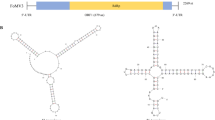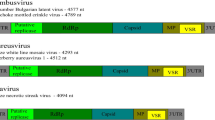Abstract
In the present study we report the identification of a novel partitivirus recovered from Miscanthus sinensis, for which the provisional name "silvergrass cryptic virus 1" (SgCV-1) is proposed. High-throughput sequencing (HTS) and rapid amplification of cDNA ends (RACE) allowed the assembly of the complete sequence of each double-stranded RNA genome segment of this novel virus. The largest dsRNA segment, dsRNA1 (1699 bp), was predicted to encode a viral RNA-dependent RNA polymerase protein (RdRp) with 478 aa, and dsRNA2 (1490 bp) and dsRNA3 (1508 bp) were predicted to encode putative capsid proteins (CPs) with 347 and 348 aa, respectively. SgCV-1 has the highest amino acid sequence identity (≤ 70.80% in RdPp and ≤ 34.5% in CPs) to members of the genus Deltapartitivirus, family Partitiviridae, especially to unclassified viruses related to members of this genus. Its genome segment and protein lengths are also within the range of those of deltapartitiviruses. Moreover, phylogenetic analysis based on RdRp amino acid sequences also showed clustering of this novel virus with the related unclassified deltapartitiviruses. An RT-PCR survey of 94 imported M. sinensis samples held in quarantine identified seven additional samples carrying SgCV-1. This new virus fulfils all ICTV criteria to be considered a new member of the genus Deltapartitivirus.


Similar content being viewed by others
Data availability
The complete sequences of the three genome segments of the new partitivirus characterized in the present study are openly available in the GenBank database with reference numbers MZ751043, MZ751044, and MZ751045.
References
Dougherty RF, Quinn LD, Endres AB et al (2014) Natural history survey of the ornamental grass Miscanthus sinensis in the introduced range. Invasive Plant Sci Manag 7:113–120. https://doi.org/10.1614/ipsm-d-13-00037.1
McCalmont JP, Hastings A, McNamara NP et al (2017) Environmental costs and benefits of growing Miscanthus for bioenergy in the UK. GCB Bioenergy 9:489–507. https://doi.org/10.1111/gcbb.12294
van der Weijde T, Kiesel A, Iqbal Y et al (2017) Evaluation of Miscanthus sinensis biomass quality as feedstock for conversion into different bioenergy products. GCB Bioenergy 9:176–190. https://doi.org/10.1111/gcbb.12355
Nakajima T, Yamada T, Anzoua KG et al (2018) Carbon sequestration and yield performances of Miscanthus × giganteus and Miscanthus sinensis. Carbon Manag 9:415–423. https://doi.org/10.1080/17583004.2018.1518106
Sabanadzovic S, Abou Ghanem-Sabanadzovic N (2009) Molecular characterization and detection of a tripartite cryptic virus from rose. J Plant Pathol 90:287–293. https://doi.org/10.4454/jpp.v90i2.664
Filippou C, Coutts RHA, Stevens DA et al (2020) Completion of the sequence of the Aspergillus fumigatus partitivirus 1 genome. Arch Virol 165:1891–1894. https://doi.org/10.1007/s00705-020-04660-0
Ahmed I, Li P, Zhang L et al (2020) First report of a novel partitivirus from the phytopathogenic fungus Fusarium cerealis in China. Arch Virol 165:2979–2983. https://doi.org/10.1007/s00705-020-04802-4
Svanella-Dumas L, Theil S, Barret M, Candresse T (2018) Complete genomic sequence of Raphanus sativus cryptic virus 4 (RsCV4), a novel alphapartitivirus from radish. Arch Virol 163:1097–1100. https://doi.org/10.1007/s00705-017-3693-6
Vong M, Ludington JG, Ward HD, Nibert ML (2017) Complete cryspovirus genome sequences from Cryptosporidium parvum isolate Iowa. Arch Virol 162:2875–2879. https://doi.org/10.1007/s00705-017-3385-2
Vainio EJ, Chiba S, Ghabrial SA et al (2018) ICTV virus taxonomy profile: Partitiviridae. J Gen Virol 99:17–18. https://doi.org/10.1099/jgv.0.000985
Nibert ML, Ghabrial SA, Maiss E et al (2014) Taxonomic reorganization of family Partitiviridae and other recent progress in partitivirus research. Virus Res 188:128–141. https://doi.org/10.1016/j.virusres.2014.04.007
Kumar S, Subbarao BL, Kumari R, Hallan V (2017) Molecular characterization of a novel cryptic virus infecting pigeonpea plants. PLoS One 12:1–27. https://doi.org/10.1371/journal.pone.0181829
Tzanetakis IE, Price R, Martin RR (2008) Nucleotide sequence of the tripartite Fragaria chiloensis cryptic virus and presence of the virus in the Americas. Virus Genes 36:267–272. https://doi.org/10.1007/s11262-007-0186-9
Chen L, Chen JS, Zhang H, Chen SN (2006) Complete nucleotide sequences of three dsRNA segments from Raphanus sativus-root cv. Yipinghong with leaf yellow edge symptoms. Handb Environ Chem Vol 5 Water Pollut 151:2077–2083. https://doi.org/10.1007/s00705-006-0765-4
Wu LP, Du YM, Xiao H et al (2020) Complete genomic sequence of tea-oil camellia deltapartitivirus 1, a novel virus from Camellia oleifera. Arch Virol 165:227–231. https://doi.org/10.1007/s00705-019-04429-0
Jo Y, Cho WK (2020) Identification of viruses belonging to the family Partitiviridae from plant transcriptomes. bioRxi. https://doi.org/10.1101/2020.03.11.988063
Bankevich A, Nurk S, Dmitry A et al (2012) SPAdes: a new genome assembly algorithm and its applications to single-cell sequencing. J Comput Biol 19:455–477
Bigot T, Temmam S, Pérot P, Eloit M (2020) RVDB-prot, a reference viral protein database and its HMM profiles. F1000Research 8:1–13. https://doi.org/10.12688/f1000research.18776.2
Buchfink B, Xie C, Huson DH (2014) Fast and sensitive protein alignment using DIAMOND. Nat Methods 12:59–60. https://doi.org/10.1038/nmeth.3176
Kelley LA, Mezulis S, Yates CM et al (2016) The Phyre2 web portal for protein modeling, prediction and analysis. Nat Protoc 10:845–858. https://doi.org/10.1038/nprot.2015-053
Edgar RC (2004) MUSCLE: multiple sequence alignment with high accuracy and high throughput. Nucleic Acids Res 32:1792–1797. https://doi.org/10.1093/nar/gkh340
Kumar S, Stecher G, Tamura K (2016) MEGA7: molecular evolutionary genetics analysis version 7.0 for bigger datasets. Mol Biol Evol 33:1870–1874. https://doi.org/10.1093/molbev/msw054
Salem NM, Golino DA, Falk BW, Rowhani A (2008) Complete nucleotide sequences and genome characterization of a novel double-stranded RNA virus infecting Rosa multiflora. Arch Virol 153:455–462. https://doi.org/10.1007/s00705-007-0008-3
Funding
This research was supported by USDA APHIS project 20-8224-2121 IA.
Author information
Authors and Affiliations
Corresponding author
Ethics declarations
Conflict of interest
The authors declare that they have no conflict of interest.
Ethical approval
This article does not contain any studies with human participants performed by any of the authors.
Additional information
Handling Editor: Ioannis E. Tzanetakis.
Publisher's Note
Springer Nature remains neutral with regard to jurisdictional claims in published maps and institutional affiliations.
Supplementary Information
Below is the link to the electronic supplementary material.
Rights and permissions
About this article
Cite this article
Costa, L.C., Hu, X., Malapi-Wight, M. et al. Genomic characterization of silvergrass cryptic virus 1, a novel partitivirus infecting Miscanthus sinensis. Arch Virol 167, 261–265 (2022). https://doi.org/10.1007/s00705-021-05294-6
Received:
Accepted:
Published:
Issue Date:
DOI: https://doi.org/10.1007/s00705-021-05294-6




